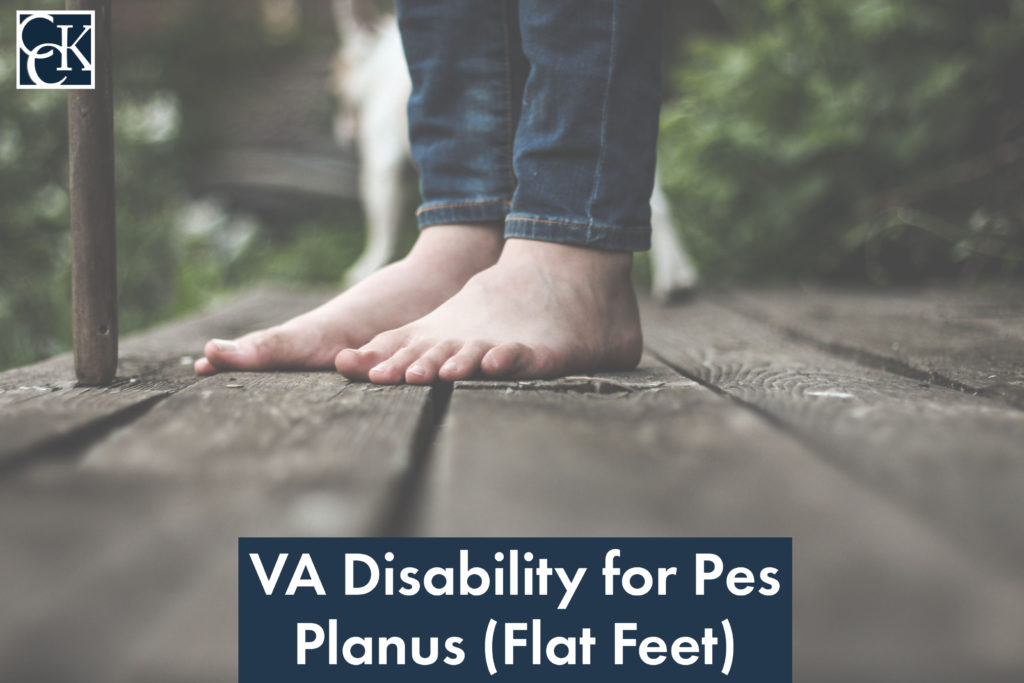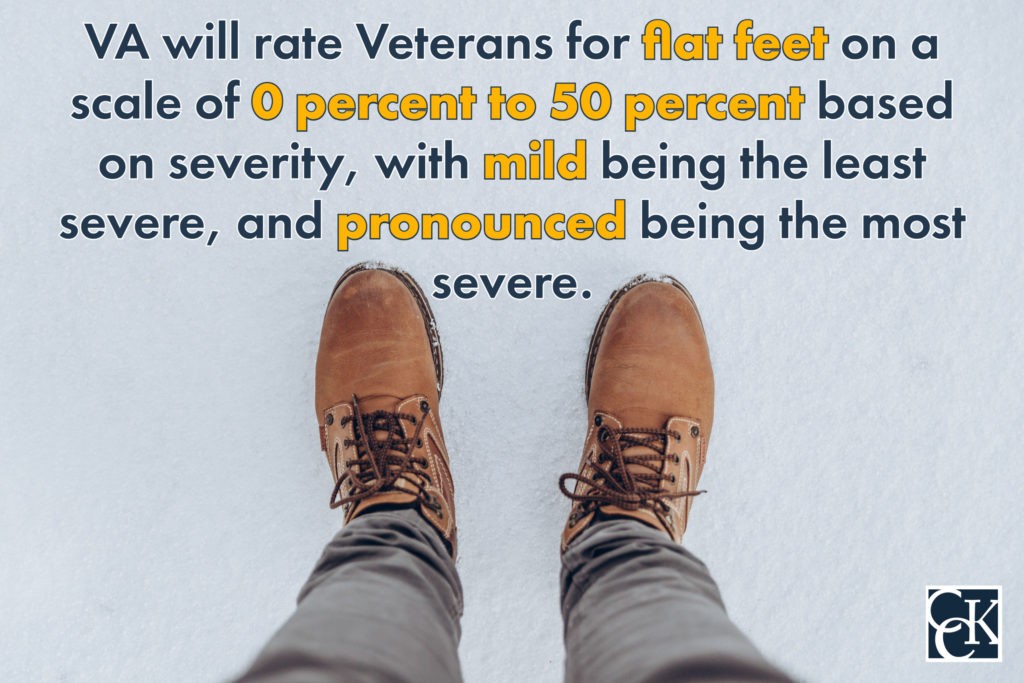VA Disability for Pes Planus (Flat Feet)

CCK Law: Our Vital Role in Veterans Law
Pes Planus, otherwise known as flat feet, is a common foot deformity in which the arch of the foot is flattened to the point where it touches, or nearly touches, the ground. The U.S. Department of Veterans Affairs (VA) awards disability benefits to veterans with moderate to severe pes planus caused or aggravated by active duty in the U.S. military. These VA disability benefits can impact a veteran’s life, so understanding pes planus VA ratings is important for veterans seeking such compensation.
In this article, CCK Law will discuss:
- Symptoms of pes planus
- Causes of flat feet
- VA disability ratings for flat feet
- And more
Symptoms of Flat Feet (Pes Planus)
Ligaments and tendons from the lower leg and the foot form the arches in people’s feet. When these tendons do not pull properly, the foot has little or no arch, resulting in flat feet.
Most of the time, those with flat feet do not experience serious symptoms, and treatment may not be necessary. However, those with more severe cases may experience symptoms such as:
- Feet tiring out easily
- Aches or pains in the areas of the arches or heels
- Foot swelling
- Difficulty performing certain foot movements, such as standing on your toes
- Leg and back pain
- Foot pain
The effects of flat feet can vary greatly from case to case. If you are experiencing symptoms of flat feet, it is important to seek medical attention. Having pes planus may increase the risk of injury or pain to your musculoskeletal system, particularly the lower limbs and lumbar spine.

What Causes Pes Planus (Flat Feet)?
Flat feet among veterans can be caused by a variety of factors. Sometimes pes planus is the direct result of service, whereas in other instances, it may have been aggravated by service.
Common causes and risk factors for developing flat feet include:
- A foot abnormality present since birth,
- Torn or stretched tendons,
- Inflammation or damage to the posterior tibial tendon, which runs from the lower leg, down to the ankle, and to the middle of the arch of the foot,
- Dislocated or broken bones in the legs or feet,
- Health conditions (e.g., rheumatoid arthritis), and
- Nerve damage, such as from peripheral neuropathy.
Other risk factors, such as obesity and partaking in frequent high-impact physical activity, like military training, may also lead to the development of flat feet.
Flat Feet (Pes Planus) VA Ratings
VA rates veterans with flatfoot under 38 C.F.R § 4.71a, diagnostic code 5276. Veterans can be rated between 0 percent and 50 percent on a scale of mild (least severe) to pronounced (most severe). The ratings for flat feet are as follows:
- Pronounced: If a veteran experiences marked pronation, inward displacement of the Achilles tendon on manipulation with spasms, and severe tenderness of the plantar surfaces of the feet, they may receive the highest rating for flat feet. To be considered pronounced, the condition cannot be helped by shoe supports and both feet must be affected.
- Veterans with pronounced bilateral flat feet are rated at 50 percent.
- Veterans with pronounced unilateral flat foot are rated at 30 percent.
- Severe: Veterans with medical evidence showing clear deformity of their foot, pain and/or swelling on use or manipulation, and characteristic callosities, may receive one of the following ratings:
- Veterans with severe bilateral flat feet are rated at 30 percent.
- Veterans with severe unilateral flat foot are rated at 20 percent.
- Moderate: If a veteran’s weight-bearing line is over the big toe rather than spread across the entire foot, there is inward bowing of the Achilles tendon, and pain on manipulation or use of the foot, they may be rated at 10 percent for both unilateral or bilateral.
- Mild: Veterans with flat feet who use arch supports to successfully relieve their symptoms are considered to have a mild, non-compensable condition and are rated at 0 percent.

Qualifying for Flat Feet VA Disability Compensation
VA awards disability benefits for pes planus (flat feet) to veterans who meet the requirements for service connection. VA grants service connection if the veteran:
- Has a current medical diagnosis for flat feet,
- Provides evidence of an in-service event or occurrence leading to the condition, and
- Presents a medical nexus opinion connecting pes planus to the in-service event.
In some cases, getting a nexus opinion entails a Compensation and Pension (C&P) exam. VA may schedule a flat feet C&P exam to determine if the veteran’s condition is “at least as likely as not” connected to their military service.
Secondary Conditions Linked to Flat Feet
Service-connected pes planus may lead to the development of secondary, sometimes more serious, conditions. Some examples include:
- Plantar fasciitis
- Degenerative disc disease (DDD)
- Calluses
- Toe deformities
- Arthritis of the Foot
- Anterior knee pain and intermittent low back pain
- And more.
If a medical professional determines your condition was caused or aggravated by pes planus, you may qualify for disability benefits for the secondary service-connected condition. Proving secondary service connection for your flat feet-related disabilities can help you maximize your VA monthly compensation amount.

Was Your VA Disability Claim for Pes Planus Denied?
Appealing a VA decision can be a challenging and complicated process. The dedicated attorneys and advocates at Chisholm Chisholm & Kilpatrick LTD have the experience and knowledge needed to help veterans navigate the appeal process and secure disability benefits.
If the Department of Veterans Affairs denied your VA claim for flat feet, reach out to CCK today to see if we may be able to help you get the compensation you deserve at 800-544-9144.
About the Author
Share this Post

